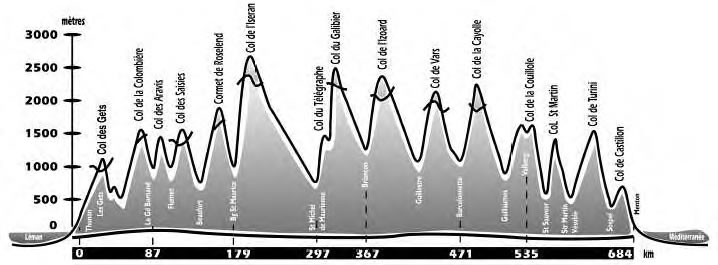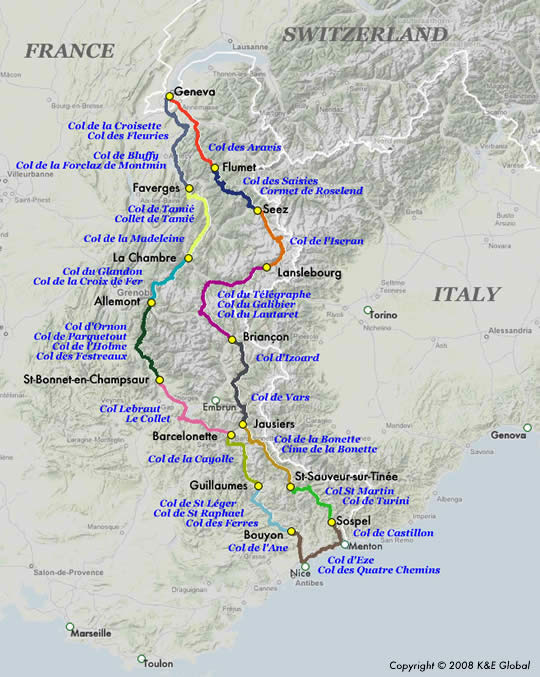- Overview
- Equipment
- Trip Details & Photos
- Conclusion
La Route des Grandes Alpes Trip Summary
Tuesday, June 24, 2008 through Thursday, July 10, 2008
Back in the summer of 2007 I (Eric) had asked Katy if we could do another multi-stage bike trip before I would turn 40. There's not much time left! My wish was to ride from Genève (Switzerland) to Menton (France) along the Route des Grandes Alpes (official website). Back in 2003 we spent a week cycling through Taiwan (view photos). As Katy is my sweet wife, she agreed. Brave! She was even the one responsible for including the return trip. Did she know what she was signing up for?
Since we had decided to do this trip on our Cannondale tandem (Katy knew very well what she was signing up for indeed), the first thing to do (for me) was to train, train and train. I have always been a cyclist, but never was too serious about it. I have to thank 2 people for giving me an extra push of motivation here.
First is my youngest brother Koen. Since the end of 2007, I managed to ride a bit more with him again. When we were kids I used to pull him over his limits: Stay in my wheel! Once in his 20’s, Koen joined a cycling club and built up a very good base; while I rode occasionally. So, now he is the one pulling me over my limits: Trying to stay in his wheel!!!
Then there is Will Davies whom I met through his website (www.cycling-challenge.com) in January 2008. Will knows all the little (but interesting) roads in a very large perimeter around Genève. For Will, “N201” (the main road between Genève and Annecy) is a dirty word. He has shown me that there are always at least 100 more destinations to explore out there.
- my old-fashioned principle of “my rides always leave from home and I always return home on my 2 wheels” with
- Koen’s “you can always push a bit harder” with
- Will’s “a ride over a col is nice, add snow and it is even nicer” and finally with
- I need to train with Katy on the tandem too.
After having ridden >5,000 km for me and 1,000 km for Katy since the start of the year, we hoped we were ready. Well, we had our Secret Weapon (SW): my parents.
My parents had happily agreed to join us on this trip...by car. Although they have already travelled through most of France, the Alps were a black spot on their map. For us, this meant we only had to take along what we needed each day. Our daily take-along items were limited to:
- pre-packed Belgian waffles + cereal bars (used many!)
- extra clothes for the descents (we were very lucky with the weather)
- bicycle repair parts (1 inner tube, patch kit, spare brake pads and some tools
 )
) - camera to keep Katy happy (this worked well


 )
)
Another big advantage of our Secret Weapon was that my parents would arrange sleep/eat accommodation for us prior to our arrival each day. This arrangement is a luxury for tired cyclists. We had chosen not to pre-book hotels in order to stay flexible. Since most of our trip took place before the French school holidays (July 5th) and before the real holiday rush (July 15th), my parents easily found accomodation. The only area where this was slightly more difficult was in the South near the Mediterranean coast. OK, my parents had a big job to do and they did great. Thanks MaPa! You really were our Secret Weapon.
The actual Route des Grandes Alpes (RGA) starts in Thonon and goes over Les Gets (Col des Gets 1,170m) and Cluses (Col de la Colombière 1,613m) to La Clusaz. As we had done both these cols from Genève in the past, we had decided to go straight over the Col des Aravis in order to reach asap the cols that would be new to us. We also wanted to do the mythical Col de la Bonette with the Cime de la Bonette at 2,802m. This again is a deviation from the pure RGA which goes over the Col de la Cayolle or the Col d’Allos (both west of Col de la Bonette). Reaching Menton would mean succeeding the first part of our challenge.
The easy solution for the return road would have been to make a complete 180° and take the same road back to Genève. This sure would have been an interesting option as riding a col from the other side makes for a whole new and different ride. However, there was more adventure in making a full circle (clockwise) by finding a different route West of RGA with more climbs. To my knowledge, there is no similar pre-chewed route as the RGA in this part of the French Alps. Therefore our return route was only determined after spending a considerable time studying maps.
True, there is the Route Napoleon (RN) which could be considered another pre-chewed RGA and which is absolutely stunning. However, I would not recommend it for cycling in its entirety. Whereas the RGA is a road recommended for cyclists, motorcyclists and cars, the reality is that it attracts more cyclists than cars (welcome to vertigo land!). For the RN, the opposite is true. Cars (and trucks on weekdays) are often kings on this one.
Getting back home on our own pedal power would mean 100% success. This was reached after 15 days in the saddle for 1,277 km. Our vertical added up to 35,330m (as per www.gpsies.com).
- Eric & Katy, 8/8/2008
La Route des Grandes Alpes Equipment
On our 2006 Cannondale Mountain Tandem we really have appreciated the following:
-
The Cannondale Tandem frame
Plenty stiff means our pedaling efforts are used for getting us up the climbs. And on the descents, the captain and stoker feel that they sit on the same bike and not on 2 bikes linked with rubber bands (especially important in turns at high speeds). The yellow/orange color made us also very recognizable.
-
The stock Avid BB-7 mechanical disc brakes with 203mm discs
They deliver instant braking power, which is a clear advantage over using a drum brake. The discs in combination with the font/rear weight on a tandem allow much better braking than on a single bike. No risks of a tire blow-out because of rim heating. On most of the descents I could operate each brake lever with 1 finger only. On my Deore V-brake equipped MTB I need 2 fingers on each lever on similar descents and I get cramped up hands way quicker. The disc brake pads had survived 1,000-1,500km riding in the mountains around Genève before our trip already and they are still not done after the trip. It is very important to keep the discs clean and free from oil/grease. I simply wiped them with a piece of cloth every 2-3 days. In my opinion, Koolstop makes perfect brake pads.
-
The standard mountain bike gearing with 44-32-22 chain rings and 11-34 cassette
We have not often used our granny gear, but the 22 front x 26 or 30 rear has enabled us to keep smiling BIG on many climbs where fellow cyclists on race bikes with triples/compacts were slowly dying.
-
SKS BXC-600 ISIS bottom bracket for stoker
Having heard about the problems that ISIS bottom brackets tend to give and having heard about the qualities of the SKS BBs, I decided to replace the stock stoker BB with the SKS BXC-600 and to keep the original BB as a spare. The SKS BB is buttery smooth.
-
Schwalbe Marathon Supreme 26x2.00 tires
We got them at a reasonable <30 EUR/piece for this high end touring tire. Zero flats and very predictable road behavior. Released for up to 140kg and can be inflated up to 5 bars (both important on a tandem). We could potentially have gone with smaller tires, but the weight/rolling resistance benefit would have been minimal. The 2.00 gives extra safety.
-
Shimano SPD pedals (pdm 540) and shoes
Nice to get off the bike and not walk around like ducks.
Our Post Tour Conclusions
- One of the nicest aspects of a tandem cycling trip is that success depends on cooperation among the participants. We (support team and tandem riders) can happily report that our 17 days away from home have only brought us closer together.
- The trip gave us the opportunity to meet so many extraordinary people who crossed our path, each with their own goals.
- A thank you to drivers in France. I guess word of their bicycle-friendly attitude has spread and that this is part of what attracts so many cyclists from all over the world to France every year.
- Food is another plus for cyclists in France (except for breakfast which is often too small). Anyone daring to open up to the local specialties will have another great experience. In every little village the bakery will always be a source for a quick energy boost. Only the kms after the last villages towards the bigger cols require that you take along your own “fuel”, even though there will almost always be a bar-restaurant at the top.
- Water is even easier. We had 4 bottles (0.5 liter each) on our tandem and never ran short. Fountains can be found everywhere along the road. These always offer safe drinking water unless explicitly marked as “non potable”. The only place we had to take more care filling up our bottles on time was along the Mediterranean coast.
- We think it is kind of comical that most highways in France are toll roads. We have been cycling along the nicest roads on the planet for free. Just shows that time (quantity) has more immediate monetary value than quality. We could discover all those beautiful regions thanks to the roads built through hard labor from many, many generations. Every year the cols are cleared from debris and snow and repaired by the road construction workers just for our pleasure. Some of them are opened for as short as 3-4 months per year. I have biked up smaller col roads before they were officially opened and the damage from snow and debris is shocking.
- Even during the height of summer, the weather can turn these cols into a winter environment. We were lucky and never had to use our winter gear. But we had it ready in case.
- All the places where we stayed were ready to offer proper “parking” for the bike at night. Our bike never had to stay outside.
- By now, many of you must have wondered about helmets. True, we hit 86 kmh so maybe a helmet would have been a good safety feature. On our list of safety priorities, helmets are completely at the bottom, just before prayers. Earlier in our list you will find speed adapted to road conditions and team’s experience, good tires and brakes and as well as full concentrated at all times. We are not against helmets and wear ours on many occasions. But it was our clear choice not to wear them on this trip and to make sure we would stay safe in all circumstances without them. We must have been lucky and we succeeded.
For additional information on La Route des Grandes Alpes:
Official website of La Route des Grandes Alpes
La Route des Grandes Alpes by Reudi Anneler of tuttoBene (in German)
La Route des Grandes Alpes by Cbandiera (in French)



